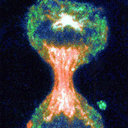5-year analysis of neoadjuvant pertuzumab and trastuzumab in patients with locally advanced, inflammatory, or early-stage HER2-positive breast cancer (NeoSphere): a multicentre, open-label, phase 2 randomised trial.
Słowa kluczowe
Abstrakcyjny
BACKGROUND
In the primary analysis of the NeoSphere trial, patients given neoadjuvant pertuzumab, trastuzumab, and docetaxel showed a significantly improved pathological complete response compared with those given trastuzumab and docetaxel after surgery. Here, we report 5-year progression-free survival, disease-free survival, and safety.
METHODS
In this multicentre, open-label, phase 2 randomised trial in hospitals and medical clinics, treatment-naive adults with locally advanced, inflammatory, or early-stage HER2-positive breast cancer were randomly assigned (1:1:1:1) to receive four neoadjuvant cycles of trastuzumab (8 mg/kg loading dose, followed by 6 mg/kg every 3 weeks) plus docetaxel (75 mg/m(2) every 3 weeks, increasing to 100 mg/m(2) from cycle 2 if tolerated; group A), pertuzumab (840 mg loading dose, followed by 420 mg every 3 weeks) and trastuzumab plus docetaxel (group B), pertuzumab and trastuzumab (group C), or pertuzumab and docetaxel (group D). After surgery, patients received three cycles of FEC (fluorouracil 600 mg/m(2), epirubicin 90 mg/m(2), and cyclophosphamide 600 mg/m(2)) every 3 weeks (patients in group C received four cycles of docetaxel prior to FEC), and trastuzumab 6 mg/kg every 3 weeks to complete 1 year's treatment (17 cycles in total). Randomisation was done by a central centre using dynamic allocation, stratified by operable, locally advanced, and inflammatory breast cancer, and by oestrogen and/or progesterone receptor positivity. Safety analyses were done according to treatment received. The primary endpoint (pathological complete response) was previously reported; secondary endpoints reported here are 5-year progression-free survival (analysed in the intention-to-treat population) and disease-free survival (analysed in patients who had surgery). Secondary and exploratory analyses were not powered for formal statistical hypothesis testing, and therefore results are for descriptive purposes only. The study ended on Sept 22, 2014 (last patient, last visit). This study is registered with ClinicalTrials.gov, number NCT00545688.
RESULTS
Between Dec 17, 2007, and Dec 22, 2009, 417 eligible patients were randomly assigned to group A (107 patients), group B (107 patients), group C (107 patients), or group D (96 patients). One patient in group A withdrew before treatment. One patient assigned to group D received group A treatment, one patient assigned to group D received group B treatment, and one patient assigned to group B received group C treatment. At clinical cutoff, 87 patients had progressed or died. 5-year progression-free survival rates were 81% (95% CI 71-87) for group A, 86% (77-91) for group B, 73% (64-81) for group C, and 73% (63-81) for group D (hazard ratios 0·69 [95% CI 0·34-1·40] group B vs group A, 1·25 [0·68-2·30] group C vs group A, and 2·05 [1·07-3·93] group D vs group B). Disease-free survival results were consistent with progression-free survival results and were 81% (95% CI 72-88) for group A, 84% (72-91) for group B, 80% (70-86) for group C, and 75% (64-83) for group D. Patients who achieved total pathological complete response (all groups combined) had longer progression-free survival compared with patients who did not (85% [76-91] in patients who achieved total pathological response vs 76% [71-81] in patients who did not achieve total pathological response; hazard ratio 0·54 [95% CI 0·29-1·00]). There were no new or long-term safety concerns and tolerability was similar across groups (neoadjuvant and adjuvant treatment periods combined). The most common grade 3 or worse adverse events were neutropenia (group A: 71 [66%] of 107 patients; group B: 59 [55%] of 107; group C: 40 [37%] of 108; group D: 60 [64%] of 94), febrile neutropenia (group A: 10 [9%]; group B: 12 [11%]; group C: 5 [5%]; group D: 15 [16%]), and leucopenia (group A: 13 [12%]; group B: 6 [6%]; group C: 4 [4%]; group D: 8 [9%]). The number of patients with one or more serious adverse event was similar across groups (19-22 serious adverse events per group in 18-22% of patients).
CONCLUSIONS
Progression-free survival and disease-free survival at 5-year follow-up show large and overlapping CIs, but support the primary endpoint (pathological complete response) and suggest that neoadjuvant pertuzumab is beneficial when combined with trastuzumab and docetaxel. Additionally, they suggest that total pathological complete response could be an early indicator of long-term outcome in early-stage HER2-positive breast cancer.
BACKGROUND
F Hoffmann-La Roche.



